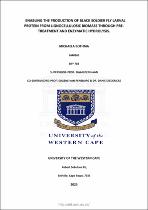| dc.description.abstract | Due to the rapid increase in the world’s population, alternative food resources are crucial to sustain the human diet. Insects can produce valuable proteins and nutrients that can be used as high-quality animal feedstuff and help to reduce organic waste. Hermetia illucens, also known as the Black soldier fly, has attracted the attention of researchers due to the veracious nature of the fly larvae (BSFL). These insects can be reared on any organic waste, consuming large quantities of raw organic material more efficiently and faster compared to other known fly species. While consuming organic waste, BSFL build up their body composition to approximately 30% fat and 40% protein, which can be a substitute for nutritionally comparable fishmeal in pet foods and animal feed. Although BSFL are mainly used for animal feed, they represent a promising source of nutrients for human consumption, although limited knowledge regarding the use of BSFL for human consumption is available. Lignocellulose could serve as an alternative, “clean” feedstock consisting of carbohydrates, that can be fed to Black soldier fly larvae. | en_US |

